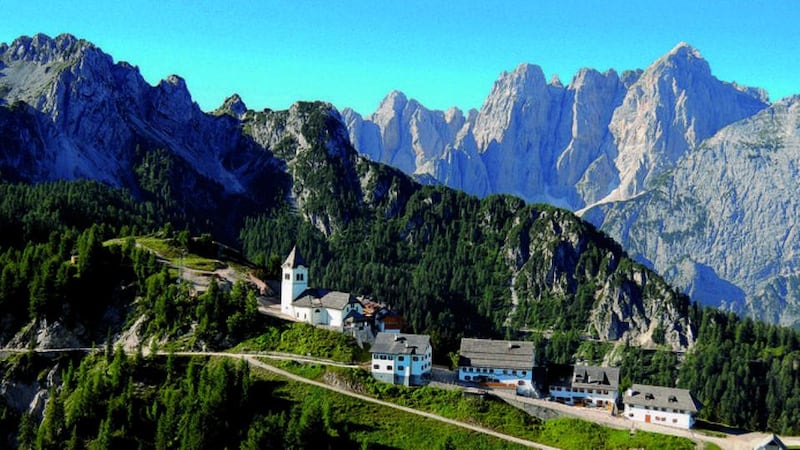There are moments that seem to come from The Sound of Music – Alpine cattle moving on hillsides, their neck-bells clanking as they go; crystal-clear streams, tiny Alpine flowers; never-ending views of ranges still to be walked.
The Alpe Adria Trail begins at the foot of Grossglockner, Austria’s highest mountain, before ending 690km and 43 stages later at Muggia, on the far side of the bay from Trieste, gazing into the azure waters of the Adriatic.
In between lies bliss. The paths have always existed, but over the past couple of years they have been brought together to form the Alpe-Adria, which passes through Slovenia along its route: 25,000 people completed it last year.

The trail starts properly at the foot of the Pasterze, the largest glacier in Austria – if one that has retreated alarmingly over recent decades because of global-warming; though nature, led by hardy Salix plants, has begun to recolonise patches frozen for thousands of years.
From there, it is a gentle walk down to Heiligenblut (“saint’s blood”), past Lake Sandersee, the Leiter waterfall and the tiny, white-washed Briccius Chapel, named after a Danish prince who died there on his return from Constantinople in 914.
The lands on all sides are part of the Carinthia National Park, where farmers are paid to work in traditional ways – using cable cars to bring hay harvested from precariously-angled fields into the attics of their homes – winter insulation, Alpine-style.
The herds of Alpine cattle, each with a leader fitted with a bell, spend June to September high in the mountains (the best time for walkers, too), and are visited every two days by their farmer owners, some coming on off-road motorcycles.
Each of the stages has its pearls; the extraordinary views on a bright, sunny day of Lake Millstätter from the Kamplnock, or a ravenously eaten lunch at the Lammersdorfer Hutte, noted for its food.
From Ossiach, the walkers begin at the abbey, before a long upward hike up the gorge to the Tauerteich pond.
In time, relief comes with a level stretch to Oberdorf, the home still to Roman graves, before heading onto the ruined Hohenwart Castle.
Twenty stages into the walk, Slovenia arrives, following a number of stiff hikes, surrounded by occasional memories of the Nazi occupation during the second World War, and the resistance offered by the Partisans.
From Trenta, a day begins with coffee at the Triglav National Information Centre before a 21km stage to Bovec, which is as popular with skiers in winter as it is with walkers in summer, though its ski-lift currently languishes unrepaired.
Here, the Alpe Adria follows the Soca Trail, along waters of astonishing purity, much favoured by fly-anglers, who regard the hunt there for marble trout as one of the world’s great fishing experiences.
The Soca was better known to the world as the Isonzo, the scene of 12 battles between Austro-Hungarian forces and the Italians in the first World War, where 300,000 men lost their lives amid scenes of extraordinary suffering.
Between Breg and Dobrovo, the walker passes through vineyard after vineyard, where vines soak up the scorching sun. As I pass through, church bells in the distance across the Italian border are ringing to mark Ferragosto, the Feast of the Assumption, a holiday since pre-Christian times.
Wine dominates everything here. In Communist times, the land was seized and operated by collective farms. Today, the descendants of some of the original owners are back on part of their estates, such as the Sirk family, who offer beautiful rooms in their simple chateau.
The Bjana estate dates back to the 13th century, coming into the family’s hands when it was bought after the first World War by Miran Sirk’s great-grandfather, Franc Obljubek.
Today, resting walkers can go into the cellars for a taste of the some Bjana’s sparkling wines.
Further along the trail, a day begins at Duino, a 14th century castle built on the cliffs overlooking the Gulf of Trieste, once the home of one branch of the Thurn und Taxis line of nobility.
There, the Bohemian-Austrian poet, Rainer Maria Rilke, noted for his mystical writings and still regarded as one of the most important poets in the German language, began one of his most famous works, the Duino Elegies .
Here, the trail suffers a slight complication due to disagreement over access to part of the path to Prosecco. The Italian authorities could do more to guide walkers around the disruption
The extraordinary cross-fertilisation of cultures down through the centuries is still evident in Trieste, the home for several periods to James Joyce before and after the first World War, where he taught English in a Berlitz class and mused about importing Irish tweed.
The walk from Trieste to Muggia takes visitors around by the Karst Plateau, a 500m-high escarpment, along trails that marked a border during the Cold War between the West and Yugoslavia, where a once fully functioning border post still stands. Walkers still sign the visitors’ book.
Sitting on a rock by the sea’s edge, there is relief, perhaps some stiffness in joints, but pleasure, too.
The Alpe Adria, despite a few flaws with sign-posting in parts, is one of Europe’s greatest walking experiences. It is just that not many people know it yet.












